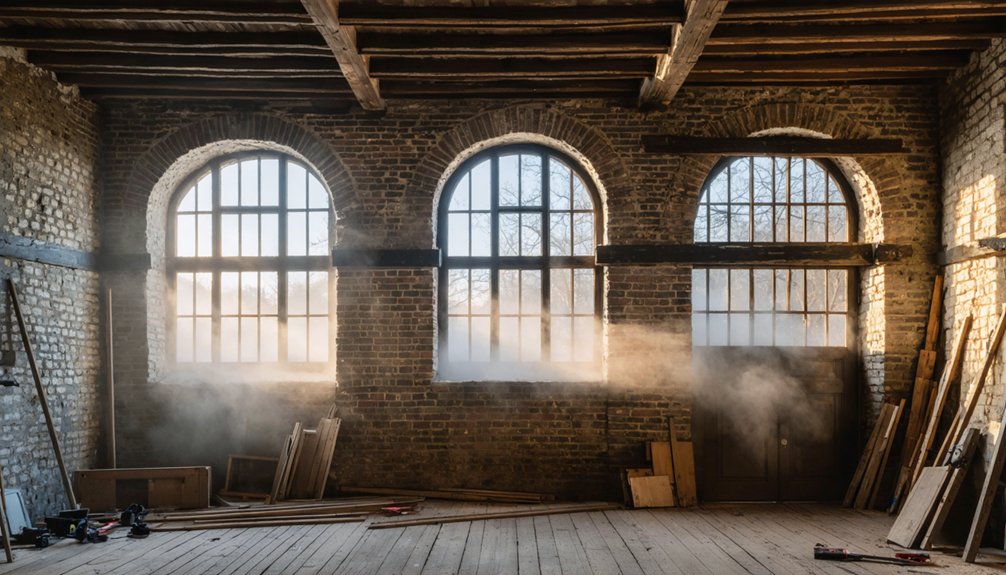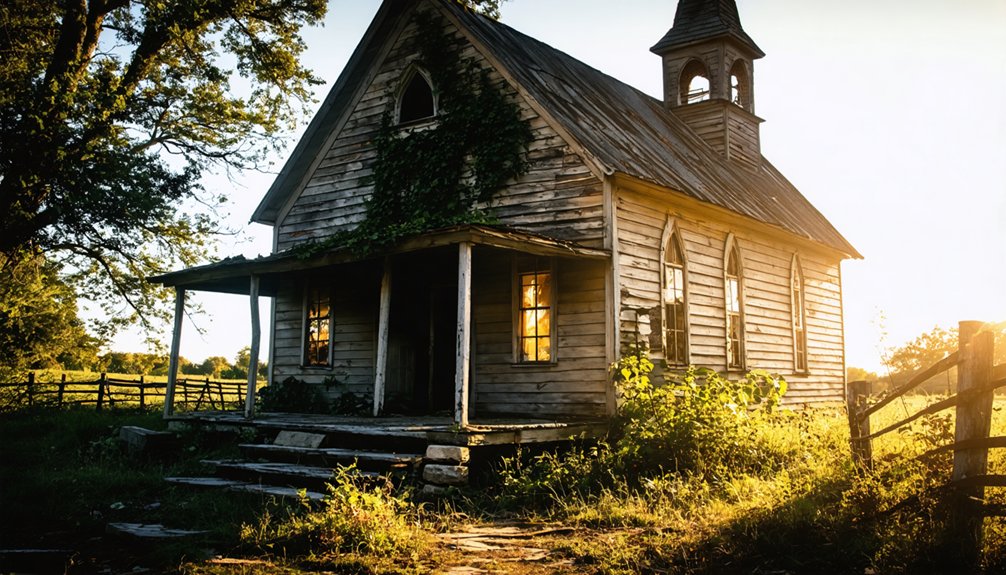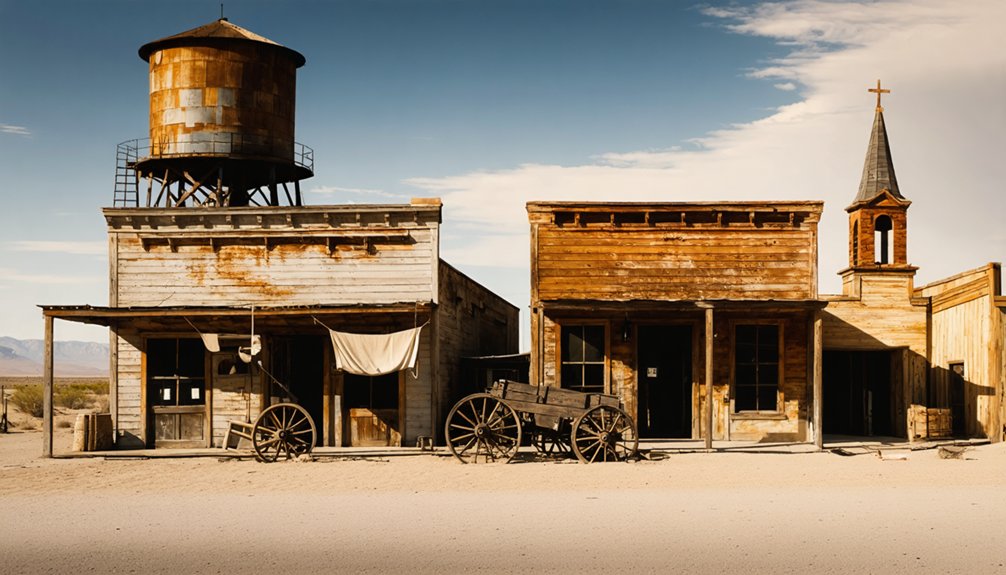You’ll find America’s most haunted colonial ruins haunted by tragic figures: Cahawba’s blue spectral lantern representing thousands of Union prisoners who perished in Alabama’s Castle Morgan; Dogtown’s guardian spirit Black Neil, who froze to death in winter 1830 as the settlement’s last inhabitant; and Jamestown’s colonial specters from the 1609-1610 “Starving Time,” where desperate cannibalism left paranormal imprints. These spectral legacies offer profound glimpses into forgotten American suffering.
Key Takeaways
- Cahawba’s blue lantern phenomenon is linked to the 3,000 Union soldiers who suffered in the overcrowded Confederate prison.
- Black Neil’s spectral form is said to guard the abandoned cellar holes of Dogtown as its final resident.
- Jamestown’s Starving Time haunting features ghostly figures that vanish upon approach and unexplained weeping after sunset.
- Archaeological equipment malfunctions and cold spots at Jamestown are associated with sites of colonial cannibalism.
- Ghost towns like Cahawba, Dogtown, and Jamestown preserve tragic histories through paranormal activity that intensifies during significant dates.
The Restless Spirits of Union Prisoners at Cahawba, Alabama
While Alabama’s first state capital Cahawba now stands in ruins, its history as a Confederate prison camp has left an indelible mark on the spiritual landscape.
You’ll encounter the haunting legacy of Castle Morgan, a converted cotton warehouse where over 3,000 Union soldiers were crammed into space meant for just 500.
These Cahawba hauntings manifest most significantly as a mysterious blue lantern floating through the darkness—believed to be connected to the prisoners who suffered deplorable conditions and rampant disease.
Union soldier spirits are particularly active near the prison ruins and local cemeteries, where many who perished in captivity were buried.
Their presence intensifies the town’s ghostly reputation, documented by paranormal investigators who record unexplained phenomena among the crumbling structures.
In April 1865, a devastating flood inundated the prison and surrounding areas, adding to the prisoners’ misery.
These restless souls represent those who never made it home, including victims of the tragic Sultana steamboat disaster.
After the Civil War, the area was settled by emancipated slaves who revitalized Cahawba briefly as a cotton production center before its eventual abandonment.
Black Neil’s Eternal Presence in Dogtown, Massachusetts
Among the isolated boulder-strewn landscape of Dogtown, Massachusetts, a different kind of ghostly presence lingers compared to Alabama’s prison spirits.
Cornelius Finson—known as Black Neil—was the last inhabitant of this abandoned village, working as a fishery clerk and hog slaughterer before meeting his tragic end.
When discovered in the winter of 1830, Black Neil lay half-dead with frozen feet in a cellar hole where he’d lived after his house collapsed.
Though rescued and taken to Gloucester’s poorhouse, he died within a week, permanently marking Dogtown’s final abandonment.
Black Neil’s legacy endures in local folklore, with many believing his spirit still haunts the cellar hole where he suffered.
His solitary existence and death transformed him into the guardian spirit of a ghost town that now attracts those seeking encounters with colonial America’s forgotten souls.
The area that became a desolate ghost town was once a thriving settlement where approximately 20% of Gloucester’s population resided during its peak before the dramatic decline.
Visitors today can explore the numbered cellar holes that remain as the only physical evidence of Dogtown’s once-vibrant community.
Echoes of the Starving Time: Jamestown’s Colonial Specters
Unlike the isolated hauntings of Dogtown, Jamestown’s spectral legacy emerges from one of America’s most devastating colonial tragedies. The winter of 1609-1610 claimed 75% of the settlement’s population through starvation, disease, and desperation—conditions that seem to have tethered their spirits to this historic ground.
- Visitors report ghostly encounters near the original fort site, often describing figures in period clothing who vanish when approached.
- Unexplained sounds of weeping and cries for help are frequently documented after sunset.
- Archaeologists have noted equipment malfunctions and cold spots at locations where evidence of cannibalism was discovered.
- Spectral sightings often intensify during winter months, mirroring the timeline of the Starving Time.
- Park rangers have collected hundreds of accounts describing sensations of being watched by unseen eyes.
The most chilling paranormal accounts come from the area where archaeological digs uncovered the remains of a teenage girl showing signs of butchering, grim evidence of the desperate measures taken by the starving colonists. The severe drought conditions that plagued the settlement during this period are believed by paranormal researchers to have intensified the suffering that created these lingering spirits.
Frequently Asked Questions
What Equipment Do Ghost Hunters Use at Colonial Sites?
You’ll need EMF detectors, digital recorders for EVPs, thermal cameras, infrared equipment, spirit boxes, and traditional tools like compasses and notebooks when ghost hunting at these historic locations.
Are Paranormal Investigations Permitted at These Historic Locations?
You’ll need to navigate paranormal regulations at colonial sites. Many require written permissions, while others prohibit investigations entirely. Research historical permissions before visiting to avoid legal consequences and preserve your investigative freedom.
Do Reported Hauntings Follow Seasonal Patterns?
Yes, seasonal hauntings exhibit distinct patterns. You’ll notice ghostly activities increase during fall and winter months, influenced by environmental factors, historical anniversaries, and cultural narratives surrounding these atmospheric periods.
How Have Indigenous Spirits Been Documented in Colonial Ghost Towns?
You’ll find indigenous spirits in colonial ghost towns documented through settler-centric perspectives that appropriate indigenous folklore while obscuring living presence. Spirit encounters reflect colonial anxiety, territorial guilt, and Indigenous resistance to cultural erasure.
What Scientific Explanations Exist for the Reported Phenomena?
You’ll find scientific explanations in rational skepticism about infrasound, carbon monoxide poisoning, sleep paralysis, psychological expectations, and perceptual biases—all understood through historical context rather than supernatural frameworks when examining evidence.
References
- https://www.mentalfloss.com/geography/wanderlust/creepiest-ghost-towns-united-states
- http://etd.auburn.edu/bitstream/handle/10415/3237/Leah W Craig Thesis.pdf.txt?sequence=5&isAllowed=y
- https://www.notesfromthefrontier.com/post/untitled
- https://www.gothichorrorstories.com/real-ghost-stories/
- https://www.christywanders.com/2024/08/top-ghost-towns-for-history-buffs.html
- https://digitalcommons.usf.edu/cgi/viewcontent.cgi?article=8126&context=etd
- https://www.geotab.com/ghost-towns/
- https://digitalcommons.usu.edu/cgi/viewcontent.cgi?article=1017&context=usupress_pubs
- https://en.wikipedia.org/wiki/Lists_of_ghost_towns_in_the_United_States
- https://www.scribd.com/document/667333822/Ghosts-and-Haunted-Places-Mysteries-Legends-And-Unexplained-Phenomena-PDFDrive



